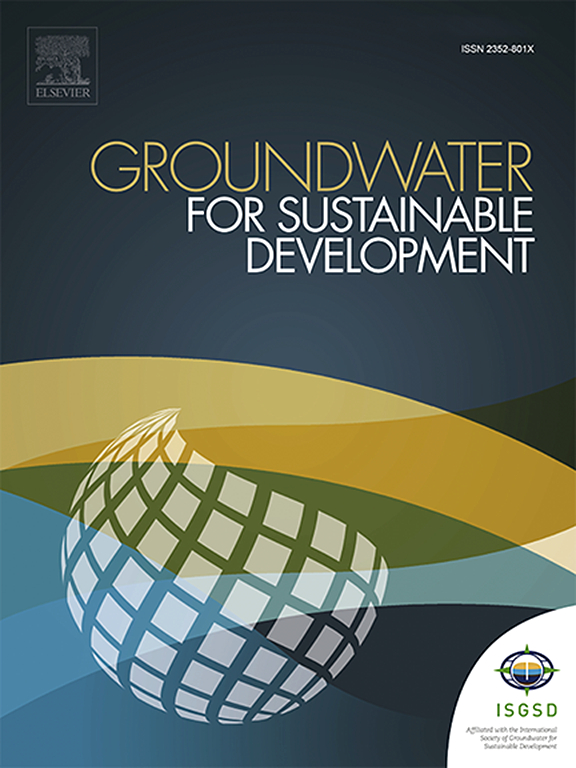Risk assessment of not meeting environmental objectives related to protection of human health and groundwater quality: The tiered approach in the context of the EU water framework directive
IF 4.9
Q2 ENGINEERING, ENVIRONMENTAL
引用次数: 0
Abstract
This paper presents the tiered approach to risk assessment, aiming to recognize groundwater bodies for which it can be unequivocally defined, with an established confidence level, whether they are at risk of not meeting environmental objectives of the EU Water Framework Directive (WFD) related to the protection of drinking water protected areas and groundwater itself. As an upgrade of the risk screening tools derived in the context of the Common Implementation Strategy (CIS) of the WFD, the robust and comprehensive approach to risk assessment extensively addresses data uncertainty and confidence assessment. If a risk assessment is conducted with low confidence, further data collection on pressures, chemical status and hydrogeological characteristics is carried out, which lasts until data are of sufficient quality to make a reliable prediction in outcomes. The tiered approach is combined with the confidence assessment focusing the research to areas of high uncertainty and low degree of confidence. To test this approach, groundwater chemical data from the groundwater body (GWB), which is typical for the Pannonian region of Croatia, were used. The Tier 1 semi-quantitative risk screening resulted in development of the GIS-based risk map for the selected GWB. The Tier 2, monitoring-based risk assessment, was carried out by applying: a) relevant criteria to conduct trend analysis and to characterize the risk of deterioration of GWB chemical status and b) risk-based classification tests, in combination with the confidence assessment of tests results. Results of the assessment of risk of not meeting the “implement measures to reverse trends” and the “prevent GWB status deterioration” objectives for the selected GWB did not reveal an existence of environmentally significant trends and an exceedance of risk-based quality standards and threshold values with arithmetic and/or spatial means of targeted substances. The risk-based classification tests results confirmed no significant risk of not meeting good GWB chemical status related to the protection of human health and groundwater. All results demonstrate that proposed approach to risk assessment is straightforward and operational for use if a high-quality data derive from a high-resolution conceptual model of a GWB.

未达到与保护人类健康和地下水质量有关的环境目标的风险评估:欧盟水框架指令背景下的分层方法
本文提出了风险评估的分层方法,旨在识别地下水体,其可以明确定义,建立置信水平,他们是否有风险不符合欧盟水框架指令(WFD)有关保护饮用水保护区和地下水本身的环境目标。作为在《世界粮食计划署共同实施战略》背景下衍生的风险筛查工具的升级版,稳健和全面的风险评估方法广泛解决了数据不确定性和置信度评估问题。如果风险评估的置信度较低,则需要进一步收集有关压力、化学状况和水文地质特征的数据,直至数据质量足以对结果作出可靠预测为止。分层方法与置信度评估相结合,将研究重点放在高不确定性和低置信度的领域。为了测试这种方法,使用了克罗地亚潘诺尼亚地区典型的地下水体(GWB)的地下水化学数据。一级半定量风险筛选为选定的GWB开发了基于gis的风险图。第2层,基于监测的风险评估,通过应用:a)进行趋势分析和描述GWB化学品状况恶化风险的相关标准和b)基于风险的分类测试,并结合测试结果的置信度评估进行。对所选GWB不符合“采取措施扭转趋势”和“防止GWB状况恶化”目标的风险评估结果未显示存在环境显著趋势,以及超出基于风险的质量标准和目标物质的算术和/或空间均值阈值。基于风险的分类测试结果证实,与保护人类健康和地下水相关的良好GWB化学状态没有达到重大风险。所有结果都表明,如果高质量数据来自高分辨率的GWB概念模型,则建议的风险评估方法是直接和可操作的。
本文章由计算机程序翻译,如有差异,请以英文原文为准。
求助全文
约1分钟内获得全文
求助全文
来源期刊

Groundwater for Sustainable Development
Social Sciences-Geography, Planning and Development
CiteScore
11.50
自引率
10.20%
发文量
152
期刊介绍:
Groundwater for Sustainable Development is directed to different stakeholders and professionals, including government and non-governmental organizations, international funding agencies, universities, public water institutions, public health and other public/private sector professionals, and other relevant institutions. It is aimed at professionals, academics and students in the fields of disciplines such as: groundwater and its connection to surface hydrology and environment, soil sciences, engineering, ecology, microbiology, atmospheric sciences, analytical chemistry, hydro-engineering, water technology, environmental ethics, economics, public health, policy, as well as social sciences, legal disciplines, or any other area connected with water issues. The objectives of this journal are to facilitate: • The improvement of effective and sustainable management of water resources across the globe. • The improvement of human access to groundwater resources in adequate quantity and good quality. • The meeting of the increasing demand for drinking and irrigation water needed for food security to contribute to a social and economically sound human development. • The creation of a global inter- and multidisciplinary platform and forum to improve our understanding of groundwater resources and to advocate their effective and sustainable management and protection against contamination. • Interdisciplinary information exchange and to stimulate scientific research in the fields of groundwater related sciences and social and health sciences required to achieve the United Nations Millennium Development Goals for sustainable development.
 求助内容:
求助内容: 应助结果提醒方式:
应助结果提醒方式:


